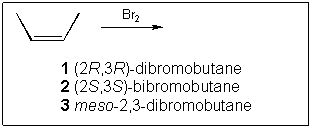|
1. Which of the following
reactions of alkenes is not stereospecific?
(A) bromination (treatment with Br2 in CHCl3)
(B) hydrogenation (treatment with H2/Pt)
(C) acid-catalyzed hydration (treatment with aqueous H2SO4)
(D) bromohydrin formation (treatment with Br2/H2O)
2. What is the major organic product obtained from the following reaction?

(A) 1
(B) 2
(C) 3
(D) 4
3. What is the major organic product obtained from the following reaction?
 (A) 1
(B) 2
(C) 3
(D) 4
4. What is (are) the major organic product(s) obtained from the following reaction?

(A) only 1
(B) only 2
(C) only 3
(D) only 1 and 2
5. What is the major organic product obtained from the following reaction?
 (A) 1
(B) 2
(C) 3
(D) 4
6. What is the best choice of reagent(s) to perform the following transformation?
 (A) O3; followed by (CH3)2S
(B) Hg(OAc)2 and H2O; followed by NaBH4
(C) BH3; followed by H2O2, NaOH
(D) OsO4; followed by NaHSO3
7. What type of reactive
intermediate is formed in the reaction of an alkene with Br2 and
water to give a bromohydrin?
(A) carbocation
(B) carbanion
(C) radical
(D) cyclic bromonium ion
8. What type of reaction mechanism accounts for the reaction of an alkene with HBr
to give an alkyl bromide?
(A) nucleophilic addition
(B) electrophilic addition
(C) radical addition
(D) elimination
9. Which of the following alkenes undergoes the least exothermic hydrogenation upon treatment with H2/Pd?
 (A)
1
(B)
2
(C)
3
(D)
4
10. Which of the following
concepts explains Markovnikovís rule as applied to the addition of HBr to
propene? (A) the relative stability of carbocations
(B) the nucleophilicity of bromide anion
(C) the acidity of HBr
(D) the Aufbau principle
|